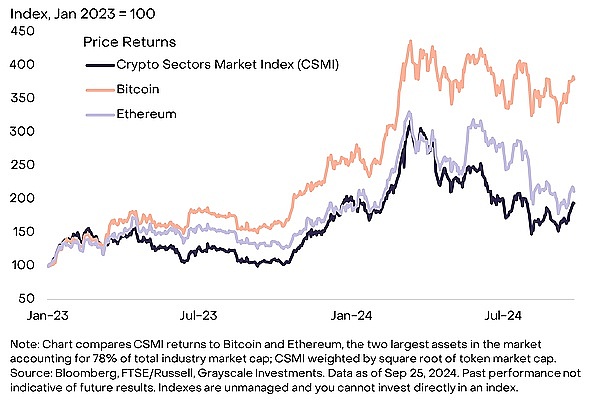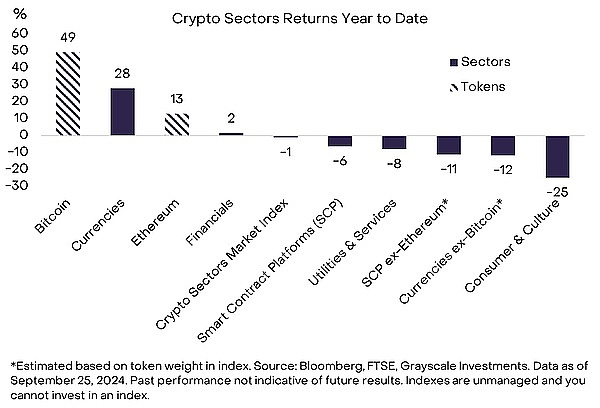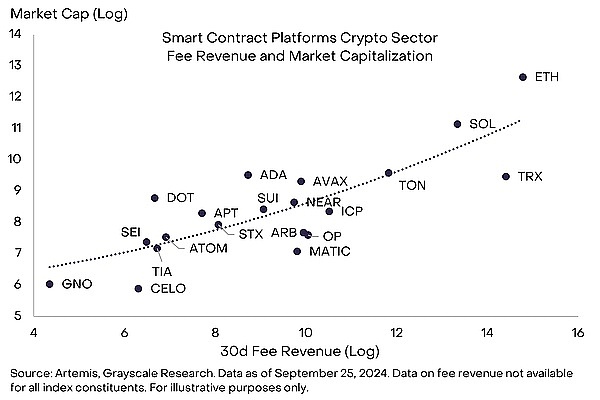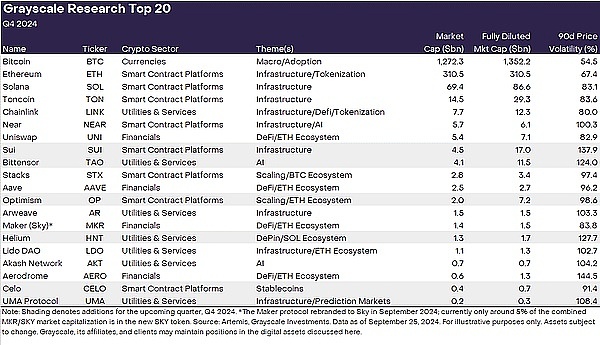Author: Grayscale; Compiler: iDomNews
The crypto market moved sideways in the third quarter of 2024, as assessed by the FTSE/Grayscale Crypto Industry Index Series.
This year's changes to the FTSE/Grayscale Index Series highlight emerging trends in the digital asset industry, including the rise of decentralized artificial intelligence (AI) platforms, tokenization efforts for traditional assets, and the popularity of memecoins.
Although Ethereum has underperformed Bitcoin so far this year, it still outperforms the Smart Contract Platform Crypto Industry Index. Grayscale Research believes that Ethereum has multiple reasons to remain competitive despite fierce competition in the smart contract space.
We have updated the top 20 from Grayscale Research. The top 20 represents a diverse group of assets covering the crypto sector that have high potential for the quarter ahead. New assets added this quarter are SUI, TAO, OP, HNT, CELO, and UMA.
All assets in our top 20 list have high volatility and are considered high risk; the US election may also be a significant risk factor for the crypto market.
The Grayscale Crypto Category provides a comprehensive framework for understanding the universe of investable digital assets and their relationship to the underlying technology. Based on this framework, and in partnership with FTSE Russell, we developed the FTSE Grayscale Crypto Sector Index Series to measure and track the crypto asset class (Figure 1). Grayscale Research incorporates the Crypto Sector Index into its ongoing research into the digital asset market.

Figure 1: Crypto Industry Index Measuring the Performance of Asset Classes
The Crypto Industry Framework is designed to be updated dynamically with the changing digital asset market and is rebalanced at the end of each quarter. The most recent quarterly rebalancing process was completed on September 20. Since the beginning of the year, index rebalancing has brought significant changes to the index composition, reflecting new exchange listings, asset liquidity changes, and market performance. This year’s update to the Crypto Industry Index showcases emerging themes in the digital asset industry, including the rise of decentralized AI platforms (e.g., TAO), tokenization efforts for traditional assets (e.g., ONDO, OM, and GFI), and the popularity of memecoins (e.g., PEPE, WIF, FLOKI, and BONK). From a returns perspective, the Bitcoin and Currency crypto categories outperform other market sectors in 2024 (Figure 2), which may reflect the successful listing of spot Bitcoin exchange-traded products (ETPs) in the U.S. market and a favorable macro environment (for more details, see our previous quarterly report, Grayscale Research Insights: Crypto Industry in Q3 2024).

Figure 2: Bitcoin has outperformed other assets this year, but Ethereum is not far behind
Ethereum has underperformed Bitcoin this year, up 13%, but it has still outperformed most other crypto assets. For example, our Crypto Sector Market Index (CSMI) - a measure of returns across the entire asset class - is down about 1% this year. In fact, excluding Ethereum, the Smart Contract Platform Crypto Sector Index is down about 11%, so it has significantly outperformed other assets in its market segment. Ethereum’s year-to-date returns are roughly in the 70th-75th percentile of all assets in our crypto industry framework. So while Ethereum’s gains are lower than Bitcoin’s, it’s still performing well this year compared to its crypto industry and the broader CSMI.
Focus onSmart ContractPlatforms
Unlike Bitcoin, which dominates the currency crypto industry, Ethereum faces stiff competition among smart contract platforms. This year, a number of alternative smart contract platforms have gained traction, including Solana, Toncoin, Tron, and Near, as well as the emerging Sui. These assets are all competing for fee revenue, and the superior user experience provided by some alternative smart contract platforms could lead to a decline in Ethereum Layer 1 market share.
At the same time, Ethereum has several competitive advantages in the smart contract platform crypto industry that underpin its position (Figure 3). Most importantly, it remains the leader in the category, with the most applications, the most developers, the highest 30-day fee revenue, and the highest value locked in smart contracts. When including the largest Ethereum Layer 2 network, it ranks second only to Solana in daily active users.

Figure 3: Ethereum is the category leader in terms of fee income for smart contract platforms
As public blockchain technology continues to develop, Grayscale Research expects the entire smart contract platform crypto industry to grow in users, transactions, and fees, which could benefit all assets in the category to some extent. Because Ethereum is the category leader, it is difficult to imagine a period of sustained growth in the smart contract platform segment that would not benefit Ethereum, in part due to its pre-existing network effects. As such, we believe Ethereum remains a compelling asset in the smart contract platform crypto industry, despite the significant competition it faces.
Additionally, Ethereum benefits from certain specific characteristics that may hold off competitors for some time. These characteristics include high network reliability (limited downtime), high economic security, high decentralization, and clearer regulatory status in the United States. There have also been some encouraging adoption stories within the Ethereum ecosystem, including tokenization, prediction markets, and development by companies like Sony. For these reasons, Grayscale Research continues to believe that Ethereum has a very compelling investment thesis.
Grayscale Research Top 20 Assets
Each quarter, the Grayscale Research team analyzes hundreds of digital assets to inform the rebalancing process for the FTSE/Grayscale Crypto Industry Series Index. As part of this process, Grayscale Research publishes a list of the top 20 assets under the Crypto Industry Sector. The top 20 represents a diverse group of assets that, in our view, have high potential (Figure 4). Our methodology considers multiple factors, including network growth/adoption, upcoming catalysts, fundamental sustainability, token valuation, token supply inflation, and potential tail risk.
This quarter, we added six new assets to the top 20:
Sui:A high-performance, layer-one smart contract blockchain that delivers innovative applications (see Building Block: Sui for more details).
Bittensor:A platform that facilitates the development of open, global AI systems (see Building Block: Bittensor for more details).
Optimism:An Ethereum scaling solution based on optimistic rollups (a scaling solution).
Helium:A decentralized wireless network running on Solana, a leader in decentralized physical infrastructure (DePin).
Celo:A mobile-first blockchain project transitioning to an Ethereum layer 2 network, focused on stablecoins and payments.
UMAProtocol:An optimistic oracle serving Polymarket, a leading blockchain prediction market (among other protocols).

Figure 4: High Potential Crypto Industry Assets in Q4 2024
The newly included assets reflect several crypto market themes that Grayscale Research is focusing on. Sui and Optimism are both seen as examples of high-performance infrastructure. Sui is a third-generation blockchain developed by a group of former Meta engineers. Two months ago, Sui underwent a network upgrade that increased its transaction speed by 80%, surpassing Solana, which has led to the recent increase in adoption on the network. Optimism is an Ethereum layer 2 that is helping to scale the Ethereum network and has developed a framework for building scaling solutions called Superchains, which is used by Coinbase’s layer 2 BASE and the layer 2 built by Sam Altman’s Worldcoin.
Both Celo and UMA benefit from unique adoption trends: stablecoin usage and prediction markets. Celo is a blockchain focused on stablecoins and payments in the developing world, and has gained traction in Africa through the Opera browser’s MiniPay app. Celo recently surpassed Tron as the blockchain with the highest stablecoin usage by daily addresses, and is currently migrating from a standalone blockchain to Ethereum layer 2, using Optimism’s Superchain framework. UMA is an oracle network for Polymarket, a breakthrough application for the crypto election year. UMA records every Polymarket event contract outcome on-chain and facilitates voting on disputes over Polymarket outcomes, ensuring they are resolved without centralized, arbitrary, or biased interference.
The inclusion of Helium reflects our preference for industry leaders and projects with sustainable revenue. Helium is a leader in the DePIN (decentralized physical infrastructure network) category, leveraging a decentralized model to efficiently distribute wireless network coverage and connectivity resources and reward participants for maintaining the infrastructure. Helium has scaled to over 1 million hotspots and 100,000 mobile users, generating over $2 million in network revenue to date.
Finally, while we have been focusing on the topic of decentralized AI for some time, Bittensor is only now being included in our crypto industry framework thanks to improved market structure - specifically, more available pricing sources and higher liquidity. Bittensor has become a key player at the intersection of crypto and AI, gaining traction by attempting to use economic incentives to create a global decentralized AI innovation platform.
We have removed the following projects from our top 20 this quarter: Render, Mantle, ThorChain, Pendle, Illuvium, and Raydium. Grayscale Research continues to value the value of these projects, and they remain an important part of the crypto ecosystem. However, we believe the revised top 20 list could provide more attractive risk-adjusted returns for the next quarter.
Investing in the crypto asset class involves risks, some of which are endemic to the crypto asset class, including smart contract vulnerabilities and regulatory uncertainty. In addition, all of the assets in our top 20 have high volatility and may be considered high risk and are not suitable for all investors. Finally, broader macroeconomic and financial market developments may impact the valuations of crypto assets, and the U.S. election in November is viewed as a significant risk event for the crypto markets. Former President Trump has explicitly supported the digital asset industry, and Vice President Harris recently stated that her administration "will encourage innovative technologies like AI and digital assets while protecting our consumers and investors." Given the risks facing this asset class, any investment in digital assets should be evaluated in the context of a portfolio and take into account an investor's financial goals.
 Kikyo
Kikyo








